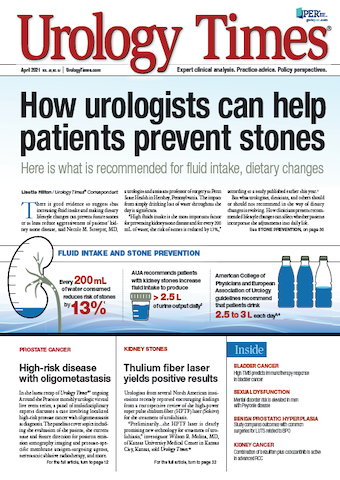Publication
Article
Urology Times Journal
PSMA theranostic 177Lu-PSMA-617 more active, safer than cabazitaxel in mCRPC
Author(s):
PSA response rate was higher with the investigational radioligand therapy.
The investigational radioligand therapy 177Lu-PSMA-617 (LuPSMA) demonstrated stronger clinical activity with fewer grade 3/4 adverse events (AEs) compared with cabazitaxel (Jevtana) in patients with metastatic castration-resistant prostate cancer (mCRPC), according to findings from the phase 2 TheraP trial published in the Lancet.1
The findings, which were previously shared during the 2020 American Society of Clinical Oncology Virtual Scientific Program,2 showed a PSA response rate of 66% with LuPSMA compared with 37% with cabazitaxel, representing a 29% absolute greater PSA response rate (P <.0001). For sensitivity analysis per protocol, the difference observed was 23% (P = .0016).
Regarding safety, grade 3/4 AEs occurred in 33% versus 53% of the LuPSMA versus cabazitaxel arms, respectively. There were no LuPSMA-related deaths.
Michael S. Hofman, FRACP, MBBS

“This phase 2 study provides evidence that [177Lu]Lu-PSMA-617 is a potential alternative to cabazitaxel in men with metastatic castration-resistant prostate cancer, with greater activity but less severe side-effects and improvements in patient-reported outcomes,” first author Michael S. Hofman, FRACP, MBBS, Peter MacCallum Cancer Center, Melbourne, Australia, and coauthors wrote.
The radiolabelled small molecule LuPSMA is a theranostic that delivers β radiation to PSMA-expressing cells. The TheraP trial enrolled 200 patients with mCRPC who progressed after docetaxel. Patients had undergone imaging with 68Ga-PSMA-11 and 18F-FDG PET/CT confirming high PSMA-expression and no sites of FDG-positive/PSMA-negative disease. Over 90% of patients in each arm had received abiraterone acetate (Zytiga), enzalutamide (Xtandi), or both.
Patients were randomized in a 1:1 ratio to LuPSMA (n = 99) or cabazitaxel (n = 101). Study treatment occurred at 11 clinical locations in Australia. In the LuPSMA cohort, men received posttreatment SPECT/CT after each cycle, with those achieving an exceptional response having their treatment paused. Treatment would subsequently resume at the time of PSA progression.
PSA response rate was the primary study end point. A response was defined as ≥50% reduction. Key secondary efficacy endpoints included PSA-PFS, AEs, and overall survival (OS).
At the time of the data analysis, there were 173 progression events, 90 and 83 in the LuPSMA and cabazitaxel cohorts, respectively. LuPSMA delayed progression versus cabazitaxel (HR, 0.63; P = .0028), with a comparable benefit observed in radiographic progression-free survival (PFS; HR, 0.64; P = .0070) and PSA-PFS (HR, 0.60; P = .0017).
The safety analysis included 98 men in the LuPSMA arm and 85 in the cabazitaxel arm. Grade 3/4 AEs occurred in 33% (n = 32) and 53% (n =45) of the 2 arms, respectively.
VISION trial
Researchers now eagerly await results from the open-label phase 3 VISION trial (NCT03511664), which accrued patients with progressive PSMA-positive mCRPC who received at least 1 novel androgen axis drug (eg, enzalutamide or abiraterone acetate) and were previously treated with 1 to 2 taxane regimens. Patients were randomized toLuPSMA plus best supportive/best standard of care or best supportive/best standard of care alone.
The primary outcome measure is OS. Secondary end points include radiographic progression-free survival, response, time to first symptomatic skeletal event, safety and tolerability, health-related quality of life, and biochemical response as measured by PSA.
Future of PSMA
PSMA-PET imaging and PSMA theranostics are becoming a mainstay in the prostate cancer paradigm, Evan Y. Yu, MD, professor in the Department of Medicine, Division of Oncology, University of Washington and Fred Hutchinson Cancer Research Center, told Urology Times in a recent interview.
In December 2020,the FDA approved gallium 68 PSMA-11 as the first drug for positron emission tomography (PET) imaging of PSMA-positive lesions in men with prostate cancer.
The FDA is currently reviewing a new drug application for the PSMA-targeted PET imaging agent 18F-DCFPyL (PyL) for prostate cancer. Under the Prescription Drug User Fee Act, the FDA is scheduled to make a decision on the application by May 28, 2021.
Reference
1. Hofman MS, Emmett, L Sandhu S, et al. [177Lu]Lu-PSMA-617 versus cabazitaxel in patients with metastatic castration-resistant prostate cancer (TheraP): a randomised, open-label, phase 2 trial. Lancet. 2021;397(10276):797-804. doi: 10.1016/S0140-6736(21)00237-3
2. Hofman MS, Emmett L, Sandhu SK, et al. TheraP: A randomized phase II trial of 177Lu-PSMA-617 (LuPSMA) theranostic versus cabazitaxel in metastatic castration resistant prostate cancer (mCRPC) progressing after docetaxel: initial results (ANZUP protocol 1603). Presented at: 2020 ASCO Virtual Scientific Program; May 29, 2020. Abstract 5500.
































